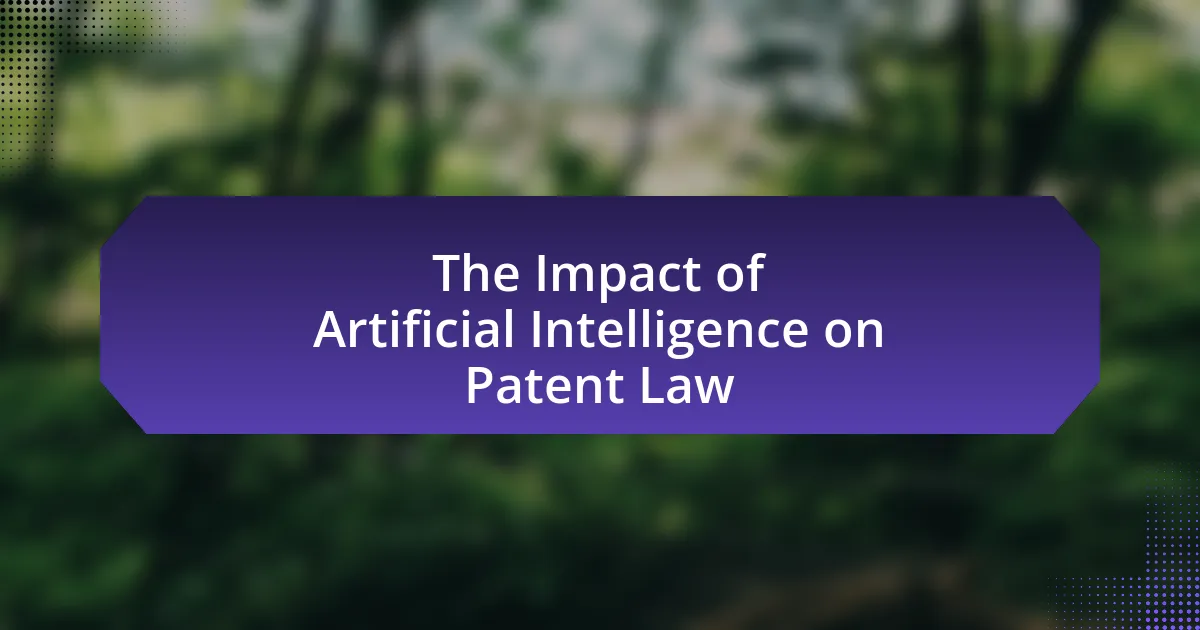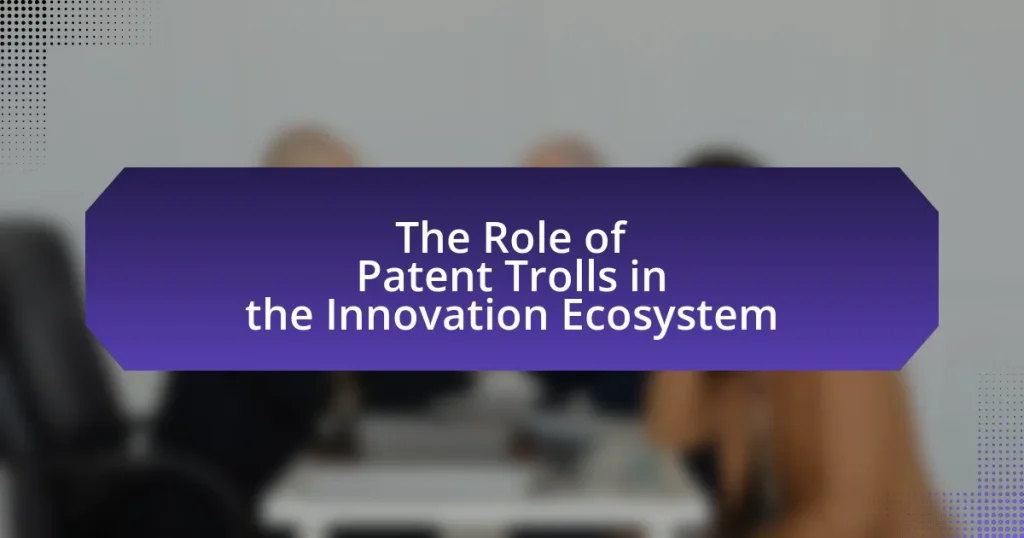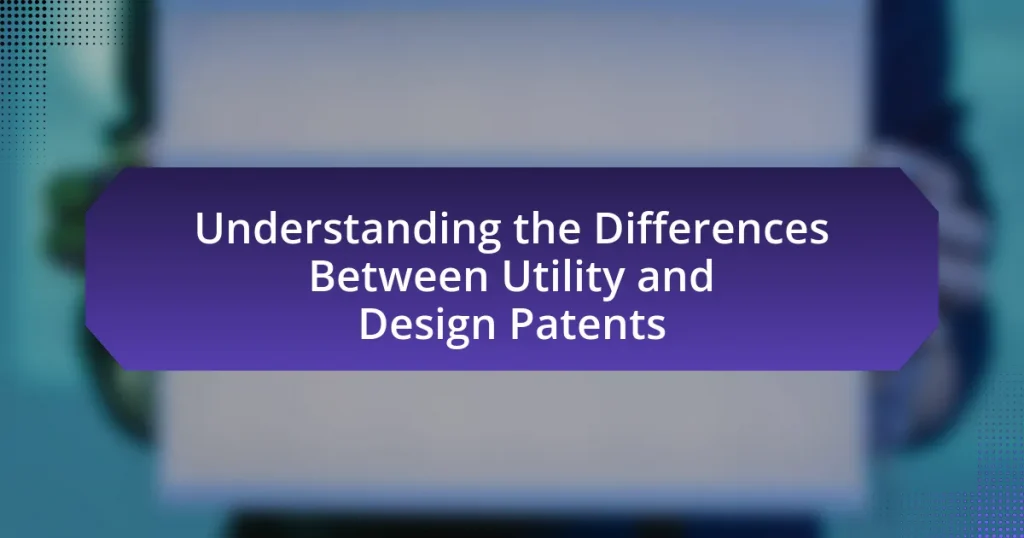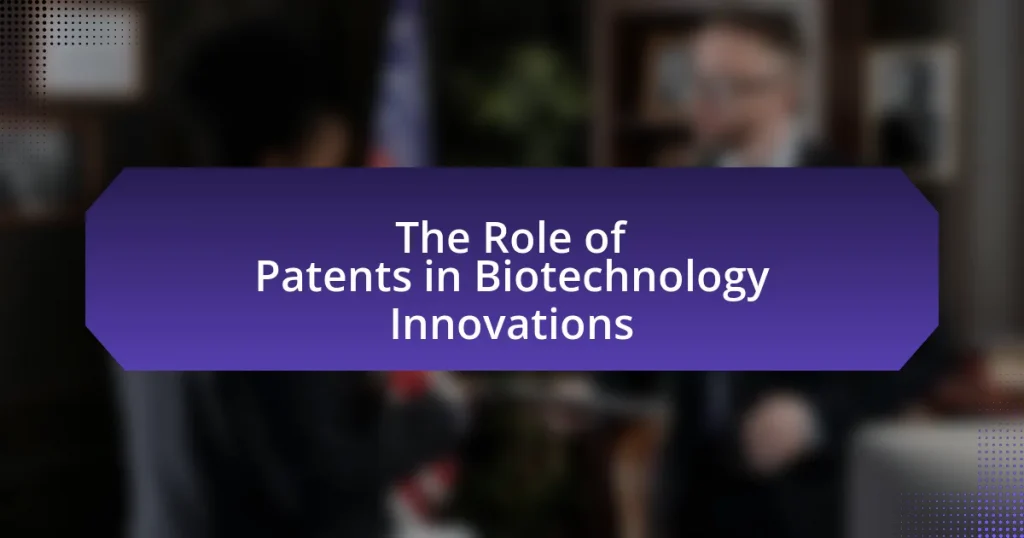The article examines the significant impact of artificial intelligence (AI) on patent law, focusing on issues such as patentability, inventorship, and enforcement. It highlights the challenges posed by AI-generated inventions, including the traditional requirement for a human inventor and the complexities surrounding novelty and non-obviousness criteria. The discussion includes how AI can enhance patent examination processes and influence innovation trends, while also addressing the evolving legal frameworks and proposed legislative changes to accommodate AI technologies in patent systems. Additionally, the article outlines best practices for inventors to navigate the complexities of patenting AI innovations effectively.

What is the Impact of Artificial Intelligence on Patent Law?
The impact of artificial intelligence on patent law is significant, as it raises questions about patentability, inventorship, and enforcement. AI technologies can create inventions autonomously, challenging traditional notions of who qualifies as an inventor under patent law, which typically requires a human inventor. For instance, in 2020, the U.S. Patent and Trademark Office (USPTO) stated that only a natural person can be named as an inventor, which complicates the patenting of AI-generated inventions. Additionally, AI’s ability to analyze vast amounts of data can streamline the patent examination process, potentially increasing efficiency but also raising concerns about the adequacy of prior art searches. Furthermore, the use of AI in patent litigation can enhance predictive analytics, impacting strategies for enforcement and defense. These developments necessitate ongoing legal adaptations to address the evolving role of AI in innovation and intellectual property rights.
How is Artificial Intelligence defined in the context of Patent Law?
Artificial Intelligence in the context of Patent Law is defined as a technology that can perform tasks typically requiring human intelligence, such as learning, reasoning, and problem-solving. This definition encompasses various AI systems, including machine learning algorithms and neural networks, which can create inventions or contribute to the inventive process. The U.S. Patent and Trademark Office (USPTO) and other patent offices worldwide have begun to address the implications of AI in patentability, particularly regarding the identification of inventors and the criteria for patent eligibility. For instance, the USPTO has issued guidelines indicating that AI-generated inventions may be patentable if they meet the standard requirements of novelty, non-obviousness, and usefulness, thereby acknowledging the evolving role of AI in innovation.
What are the key characteristics of Artificial Intelligence relevant to patents?
The key characteristics of Artificial Intelligence relevant to patents include novelty, non-obviousness, and utility. Novelty refers to the requirement that an AI invention must be new and not previously disclosed in any prior art. Non-obviousness indicates that the invention must not be an obvious improvement to someone skilled in the field, which can be challenging to assess in AI due to the rapid advancements in technology. Utility means that the AI invention must have a specific, substantial, and credible utility, which is essential for patentability. These characteristics are critical as they determine the eligibility of AI-related inventions for patent protection under patent law.
How does AI differ from traditional inventions in patent law?
AI differs from traditional inventions in patent law primarily due to its ability to autonomously generate inventions without direct human intervention. Traditional inventions typically require a human inventor who conceives and develops the idea, while AI systems can create novel solutions based on data analysis and machine learning algorithms. This distinction raises complex legal questions regarding inventorship and ownership, as current patent laws are primarily designed around human inventors. For instance, in 2020, the U.S. Patent and Trademark Office ruled that an AI cannot be listed as an inventor on a patent, highlighting the legal challenges posed by AI-generated inventions.
Why is the intersection of AI and Patent Law significant?
The intersection of AI and Patent Law is significant because it raises critical questions about the ownership and patentability of inventions generated by artificial intelligence systems. As AI technologies advance, they increasingly create innovations autonomously, challenging traditional legal frameworks that require a human inventor for patent applications. For instance, in 2020, the U.S. Patent and Trademark Office ruled that AI cannot be listed as an inventor on patent applications, highlighting the legal ambiguity surrounding AI-generated inventions. This intersection is crucial for shaping future patent policies and ensuring that the legal system adapts to technological advancements, thereby fostering innovation while protecting intellectual property rights.
What challenges does AI present to existing patent frameworks?
AI presents significant challenges to existing patent frameworks primarily due to issues of inventorship, patentability, and the rapid pace of technological advancement. Current patent laws typically require a human inventor, which complicates the recognition of AI-generated inventions. For instance, in 2020, the U.S. Patent and Trademark Office ruled that an AI system cannot be listed as an inventor, raising questions about the ownership and rights associated with AI-created innovations. Additionally, the unique nature of AI, which often involves algorithms that learn and evolve, makes it difficult to define the novelty and non-obviousness criteria essential for patentability. This complexity is further exacerbated by the speed at which AI technology evolves, outpacing the traditional patent application process, leading to potential gaps in protection and enforcement.
How might AI influence innovation and patent filing trends?
AI is likely to accelerate innovation and alter patent filing trends by enhancing research capabilities and streamlining the patent application process. The integration of AI technologies enables faster data analysis, leading to the identification of novel solutions and ideas, which can result in an increase in the number of patents filed. For instance, a study by the European Patent Office in 2020 indicated that AI-related inventions accounted for approximately 10% of all patent applications, reflecting a growing trend in AI-driven innovation. Furthermore, AI tools can assist inventors in drafting patent applications more efficiently, reducing the time and costs associated with the filing process, thereby encouraging more entities to seek patent protection for their innovations.
What are the potential benefits of integrating AI into Patent Law?
Integrating AI into Patent Law can significantly enhance efficiency and accuracy in the patent examination process. AI technologies can automate the analysis of patent applications, enabling faster identification of prior art and reducing the time examiners spend on each application. For instance, a study by the European Patent Office indicated that AI tools could improve the speed of prior art searches by up to 30%, allowing for quicker decision-making. Additionally, AI can assist in predicting patent litigation outcomes by analyzing historical data, which can inform strategic decisions for patent holders and legal practitioners. This integration not only streamlines operations but also increases the overall quality of patent examinations, leading to more robust intellectual property protection.
How can AI improve the patent examination process?
AI can improve the patent examination process by enhancing the efficiency and accuracy of prior art searches. By utilizing machine learning algorithms, AI can analyze vast databases of existing patents and scientific literature to identify relevant prior art more quickly than human examiners. A study by the European Patent Office found that AI tools can reduce the time spent on prior art searches by up to 30%, allowing examiners to focus on more complex aspects of patent applications. This increased efficiency not only accelerates the examination process but also improves the quality of patent assessments, leading to more informed decisions regarding patentability.
What role does AI play in patent analytics and strategy?
AI plays a crucial role in patent analytics and strategy by enhancing the efficiency and accuracy of patent searches, analysis, and decision-making processes. Through natural language processing and machine learning algorithms, AI can analyze vast datasets of patents, identifying trends, similarities, and potential infringements more quickly than traditional methods. For instance, a study by the European Patent Office in 2020 highlighted that AI tools can reduce the time spent on prior art searches by up to 80%, allowing companies to make informed strategic decisions regarding patent filings and litigation. This capability not only streamlines the patent application process but also aids in competitive intelligence, enabling organizations to better navigate the complex landscape of intellectual property.
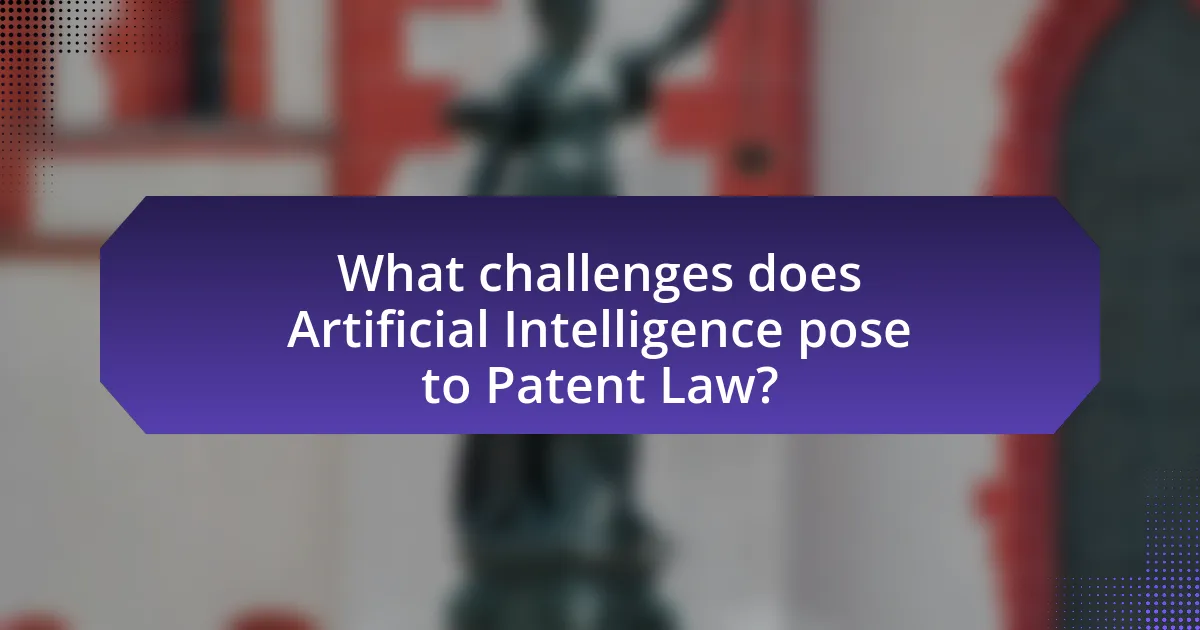
What challenges does Artificial Intelligence pose to Patent Law?
Artificial Intelligence poses significant challenges to Patent Law, primarily due to issues of inventorship, patentability, and enforcement. The traditional patent system is designed for human inventors, creating ambiguity around whether AI systems can be recognized as inventors, as seen in cases like the DABUS patent application, which was rejected in multiple jurisdictions. Additionally, the complexity of AI-generated inventions raises questions about their novelty and non-obviousness, essential criteria for patentability. Furthermore, enforcing patents on AI technologies is complicated by the rapid pace of innovation and the difficulty in determining infringement, especially when AI systems operate autonomously. These challenges necessitate a reevaluation of existing patent frameworks to accommodate the unique characteristics of AI-generated inventions.
How does AI complicate the determination of inventorship?
AI complicates the determination of inventorship by challenging traditional notions of who qualifies as an inventor. In many jurisdictions, inventorship is legally defined as the individual who contributes to the conception of the invention, but AI systems can autonomously generate ideas and solutions without human intervention. This raises questions about whether an AI can be considered an inventor, as seen in cases like the one involving the AI system DABUS, which was denied patent rights in multiple countries due to the lack of a human inventor. The legal frameworks currently in place do not adequately address the role of AI in the inventive process, leading to ambiguity and potential disputes over patent ownership and rights.
What legal precedents exist regarding AI as an inventor?
Legal precedents regarding AI as an inventor include the 2020 decision by the U.S. Patent and Trademark Office (USPTO), which ruled that only a human can be named as an inventor on a patent application. This decision was influenced by the case of Stephen Thaler, who attempted to patent inventions created by an AI system named DABUS. Similarly, the European Patent Office (EPO) also determined that an inventor must be a natural person, as established in its 2021 ruling on the same DABUS case. These rulings underscore the current legal interpretation that AI cannot hold the status of an inventor under existing patent laws.
How do different jurisdictions approach AI inventorship issues?
Different jurisdictions approach AI inventorship issues with varying degrees of recognition and legal frameworks. In the United States, the Patent and Trademark Office (USPTO) has determined that only human inventors can be named on patent applications, as established in the 2021 decision in the case of Thaler v. Hirshfeld. Conversely, the European Patent Office (EPO) allows for the possibility of AI being recognized as an inventor, but it ultimately requires a human inventor to be named in the application, as outlined in the EPO’s guidelines. In contrast, countries like Australia have recognized AI as a potential inventor, as seen in the 2021 Federal Court ruling in the case of Thaler v. Commissioner of Patents, which acknowledged that the AI system DABUS could be considered an inventor under Australian law. These differing approaches highlight the ongoing debate and legal complexities surrounding AI inventorship across jurisdictions.
What implications does AI have for patentability criteria?
AI significantly impacts patentability criteria by challenging traditional notions of inventorship and non-obviousness. The introduction of AI systems capable of generating inventions raises questions about whether these systems can be considered inventors under current patent laws, which typically require a human inventor. Additionally, AI’s ability to analyze vast datasets and identify novel solutions may lead to inventions that are deemed obvious to a human expert, thus complicating the assessment of non-obviousness, a key criterion for patentability. This shift necessitates a reevaluation of existing patent frameworks to accommodate the unique characteristics of AI-generated innovations.
How does AI challenge the novelty and non-obviousness requirements?
AI challenges the novelty and non-obviousness requirements in patent law by generating inventions that may not meet traditional criteria for originality. Specifically, AI systems can analyze vast datasets to produce solutions that resemble existing inventions, raising questions about whether these outputs are truly novel. For instance, the use of machine learning algorithms can lead to incremental improvements on existing technologies, which may be deemed obvious to a person skilled in the art. This blurs the line between what constitutes a new invention and what is merely a recombination of known elements, complicating the assessment of patentability. As a result, the legal framework may struggle to adapt to the rapid pace of AI innovation, necessitating a reevaluation of how novelty and non-obviousness are defined in the context of AI-generated inventions.
What are the implications for prior art searches in AI-generated inventions?
The implications for prior art searches in AI-generated inventions include increased complexity and the need for updated methodologies. Traditional prior art searches rely on human-created inventions and literature, but AI-generated inventions may not be easily categorized within existing frameworks. This necessitates the development of new search algorithms and databases that can effectively identify relevant AI-generated content. For instance, a study by the European Patent Office highlights that AI systems can produce novel outputs that may not have been previously documented, complicating the assessment of novelty and non-obviousness in patent applications. Consequently, patent examiners must adapt their approaches to ensure comprehensive searches that account for the unique characteristics of AI-generated inventions.
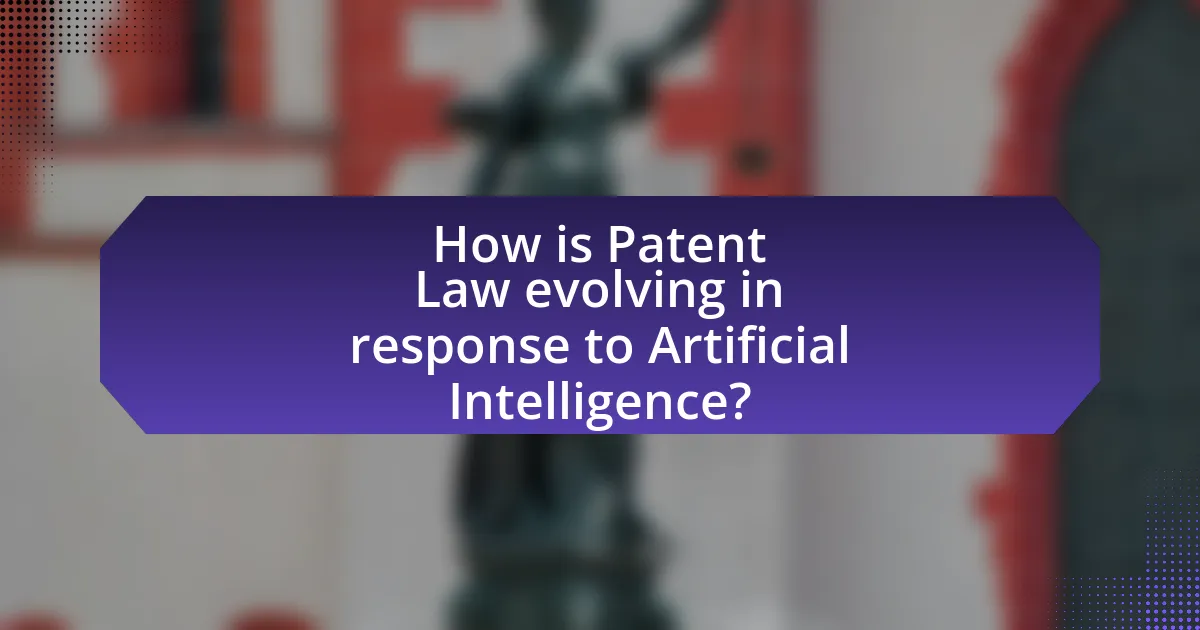
How is Patent Law evolving in response to Artificial Intelligence?
Patent law is evolving to address the challenges posed by artificial intelligence by redefining criteria for patentability, particularly concerning inventorship and the nature of inventions. Traditional patent systems require a human inventor, but advancements in AI technology have led to discussions about whether AI systems can be recognized as inventors themselves. For instance, the U.S. Patent and Trademark Office has faced cases where AI-generated inventions were submitted for patent protection, prompting legal debates and potential legislative changes. Additionally, jurisdictions like the European Union are considering amendments to patent laws to accommodate AI-generated innovations, reflecting a growing recognition of the need to adapt legal frameworks to technological advancements.
What legislative changes are being proposed to accommodate AI in Patent Law?
Legislative changes proposed to accommodate AI in Patent Law include the introduction of provisions that clarify the patentability of inventions generated by artificial intelligence systems. These changes aim to address the ambiguity surrounding whether AI can be considered an inventor under current patent laws, which traditionally recognize only human inventors. For instance, the United States Patent and Trademark Office (USPTO) has been exploring guidelines that would explicitly define the role of AI in the invention process, potentially allowing for patents to be granted for AI-generated inventions. Additionally, discussions are ongoing regarding the need for adjustments in the criteria for non-obviousness and novelty to reflect the unique capabilities of AI in generating innovative solutions.
How are patent offices worldwide adapting their guidelines for AI inventions?
Patent offices worldwide are adapting their guidelines for AI inventions by clarifying the criteria for patentability, particularly concerning novelty and non-obviousness. For instance, the United States Patent and Trademark Office (USPTO) has issued guidance emphasizing that AI-generated inventions must still meet traditional patent requirements, while the European Patent Office (EPO) has updated its practices to address the unique challenges posed by AI technologies. These adaptations reflect a growing recognition of the need to balance innovation with the established legal framework, ensuring that AI inventions are assessed fairly and consistently.
What role do international treaties play in shaping AI patent policies?
International treaties play a crucial role in shaping AI patent policies by establishing standardized frameworks for intellectual property protection across nations. These treaties, such as the Agreement on Trade-Related Aspects of Intellectual Property Rights (TRIPS), set minimum standards for patent protection that member countries must adhere to, influencing how AI innovations are patented globally. For instance, TRIPS mandates that patents must be available for inventions in all fields of technology, including AI, thereby encouraging countries to develop their own patent laws that align with international standards. This alignment fosters a more cohesive global market for AI technologies, as companies can navigate patent systems with greater predictability and security.
What best practices should inventors consider when filing patents for AI innovations?
Inventors should consider conducting a thorough prior art search when filing patents for AI innovations to ensure their invention is novel and non-obvious. This practice helps identify existing patents and publications that may affect the patentability of the innovation. Additionally, inventors should clearly define the technical problem their AI innovation addresses and articulate how their solution differs from existing technologies. This clarity enhances the patent application’s strength and increases the likelihood of approval. Furthermore, inventors should ensure that their patent claims are broad enough to cover potential variations of their invention while being specific enough to satisfy legal requirements. This balance is crucial, as overly broad claims may be rejected, while overly narrow claims may limit protection. Lastly, collaborating with a patent attorney experienced in AI technologies can provide valuable insights into navigating the complexities of patent law, ensuring compliance with legal standards and maximizing the protection of the innovation.
How can inventors ensure compliance with evolving patent laws regarding AI?
Inventors can ensure compliance with evolving patent laws regarding AI by staying informed about legislative changes and engaging with legal experts specializing in intellectual property. Regularly reviewing updates from patent offices, such as the United States Patent and Trademark Office (USPTO) and the European Patent Office (EPO), helps inventors understand new guidelines and requirements. Additionally, participating in industry forums and workshops can provide insights into best practices and emerging trends in AI patenting. Legal experts can offer tailored advice on navigating complex regulations, ensuring that inventions meet the necessary criteria for patentability.
What strategies can be employed to protect AI-related intellectual property effectively?
To protect AI-related intellectual property effectively, organizations should implement a combination of legal protections, technological measures, and strategic practices. Legal protections include filing patents for innovative AI algorithms and processes, as patents can provide exclusive rights and deter infringement. Additionally, organizations can utilize copyright to protect the source code and documentation of AI systems, while trade secrets can safeguard proprietary data and methodologies that are not publicly disclosed.
Technological measures involve employing encryption and access controls to secure AI models and datasets from unauthorized access. Regular audits and monitoring can help identify potential breaches or misuse of intellectual property. Furthermore, organizations should establish clear internal policies regarding the use and sharing of AI-related intellectual property to mitigate risks.
Strategic practices include conducting thorough IP audits to identify and assess the value of AI-related assets, as well as engaging in collaborative agreements that define ownership and usage rights in joint ventures or partnerships. By combining these strategies, organizations can create a robust framework for protecting their AI-related intellectual property in a rapidly evolving technological landscape.
